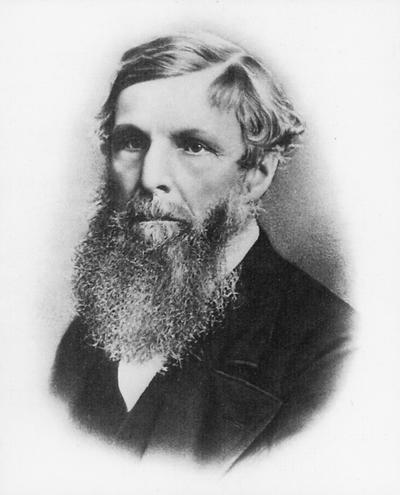William Froude was born in Dartington, Devon, England in November 28, 1810 and died
from a stroke on a cruise to Simonstown, South Africa at age 69. He was an engineer,
hydrodynamicist and naval architect.
He acquired his education in mathematics at Oxford in 1832. Immediately after
his graduation, he worked for Isambard Kingdom Burnel, the famed developer of railways, as a surveyor on the Great Western Railway,
in England. In 1837,
Froude took responsibility for the construction of a section of the Bristol and Exeter Railway.
He worked on setting out track transition curves and on the geometry of masonry skew bridges.
In 1846, he ran his family estates while working as a harbor commissioner and as a
judge of agriculture machinery for the Royal Bath and West Society. In 1857, Brunel consulted him
on the behavior of the Great Eastern ship at sea. Based on Froude's recommendations,
Brunel modified the design of the ship to avoid rolling.
Starting in 1859, Froude built the first towing tank, using his own resources.
He carried out ship model experiments using the tank,
first at his home in Paignton, and
later, in his other home, called Chelston Cross, in Torquay.
In 1861, he wrote a paper on the design of ship stability in a seaway.
The paper was published in the Proceedings of the Institution of Naval Architects. Later, between 1863 and 1867, he showed
that scaling between model and prototype (the actual ship) applied (i.e., the frictional resistance was equal)
when the speed (V) was proportional to the square root of the length (L).
He called this concept the "Law of Comparison."
V ∝ (L)1/2
V = k (L)1/2
in which k is the number that applies to both model and prototype.
This law is known as Froude's law, even though Froude himself recognized that
Ferdinand Reech (1805-1850) has presented the concept twenty
years earlier.
Froude's work was pioneering because he was the first to identify
the most efficient shape for the hull of ships,
as well as to predict ship stability with reference to reduced-scale models. Additionally, all the models,
tanks and novel instrumentation
were designed and, in many cases built by Froude himself, in his workshop at his home.
In open-channel hydraulics, Froude's Law is embodied in the Froude number, defined as:
F = V / (gD) 1/2
in which V = mean velocity, D = hydraulic depth, and g = gravitational acceleration.
Unlike Froude's original relation (k), the Froude number F is dimensionless.
The L has been replaced by D to better represent the force of gravity in open-channel flow.
This contribution was written in September of 2009 by
Fadi Khoury,
based on the available literature. Fadi graduated with an M.S. degree in
Civil Engineering from San Diego State University in June 2007.
Other sites
ponce.sdsu.edu
milestones.sdsu.edu
facets.sdsu.edu
chezy.sdsu.edu
onlinecalc.sdsu.edu
manningsn.sdsu.edu
manningsn2.sdsu.edu

